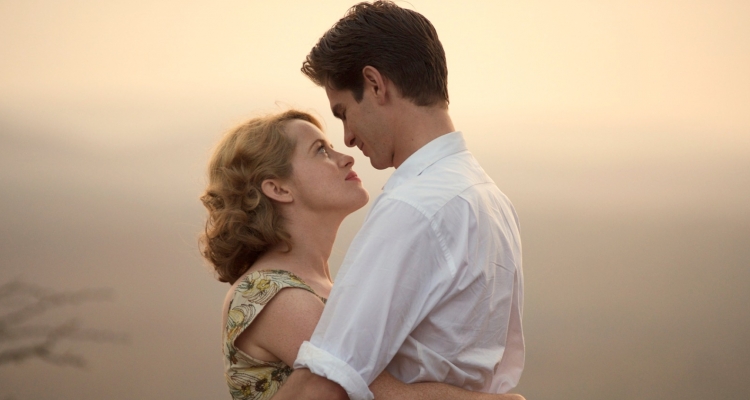TORONTO – Imagine performing a scene without moving anything but your lips, eyes and maybe your neck. And the neck can move, but just slightly. Everything else has to stay completely immobile. That includes your hands and legs. No, you can’t even shift your weight an iota. Sounds easy, right? Test it out for a minute. Maybe five. Dare you to try 10 minutes. It’s O.K., we’ll wait.
Harder than you thought, wasn’t it? That’s what’s most remarkable about Andrew Garfield’s performance in Andy Serkis’ directorial debut, “Breathe,” which debuted at the 2017 Toronto International Film Festival earlier this month.
Based on the true life of Robin Cavendish (Garfield), the picture begins in early 1950’s England where the former British Army captain is swept off his feet when he meets socialite Diana Blacker (Claire Foy). Well, we’re not exactly sure what she does besides hang around posh cocktail parties in the English countryside, but she has two entertaining older brothers who just happen to be identical twins (Tom Hollander, Serkis’ most inspired casting) and is just as charmed by Robin as much as he is with her.

Before you know it Diana agrees to follow Robin to Kenya where he’s fashioned a career for himself as a successful tea broker. The pair are accompanied by other upper crust ex-pats who wonder why she’s traveling over Africa just accompanying him. Their are soon married and their existence is pretty blissful. In fact, this version of post-WW II Kenya is the most romanticized depiction of an African nation put on screen that this critic can remember. Robin, Diana and their friends have the most elegant and dirt-free base camps you’ve ever seen. They spend their free time at the opulent British Embassy playing tennis on freshly cut grass and look like they’ve walked out of Ralph Lauren catalogues. Even Sydney Pollack’s “Out of Africa,” set fifty years prior, was a more honest depiction of rich people in Africa than this movie is.
Obviously, the party can’t last forever and after one round of tennis at the Embassy Robin starts to feel weak and oddly loses his balance. That same night he awakes feeling strange, collapses and is rushed to the hospital. Only 28, Robin is diagnosed with polio, is paralyzed from the waste down and put on a respirator so he can still breathe. It was 1958 and doctors at the time gave him just three months to live. Robin goes into a deep depression, but Diana, now pregnant with their only son Jonathan (the actual producer of the film), will have none of it. She arranges for him to be flown back to the U.K. and after his existence in state run hospital makes him suicidal, eventually makes him one of the first patients ever to live outside a medical facility on a ventilator. Robin’s spirits improve in their picturesque country home, but it’s thanks to the ingenuity of his friend Teddy Hall (Hugh Bonneville, solid) that his life completely transforms into something inspirational.
Granted, Garfield isn’t the first actor to attempt to play a character who has a paralyzing disability. Notably, Eddie Redmayne won an Oscar for his portrayal of Stephen Hawking, who has suffered from ALS for over 50 years, in “The Theory of Everything.” Garfield’s performance is just as impressive if not for different reasons. When Robin’s tube gets disconnected (and it happens a number of times) Garfield has to portray his character’s panic and still keep the rest of his body, neck, etc. immobile. Like Redmayne though, he’s able to use the rest of his face to convey a portrayal of a man at first suffering from a presumably dark fate and then shockingly enlightened by unexpected possibilities. Garfield also has to make us pay attention and root for a character who can only express his emotions through his face. That harder than it seems when every shot simply can’t be a close up.
Foy, even moreso than Felicity Jones in “Theory,” has to be the captivating force that keeps the rest of the film moving when Robin cannot. Considering how much Diana seems unprepared for her new caretaker role, Foy makes her inspirational arc both believable and poignant.
The film has some things to say about how the world has treated people with disabilities over the past half century, but it sort of gets lost in Robin and Diana’s story. Moreover, Serkis’ direction overall is, frankly, disappointing. He fashions the film as though it was a prestige picture a big Hollywood studio would have greenlit 15 years ago. And, we’ll give credit where credit is due, it looks much more expensive than it no doubt cost, but there is nothing inspired about how Serkis tells the story. It feels formulaic and dated when it should feel at least slightly unconventional and have a hint of realism. Again, it looks gorgeous, but there never feels like there is a truly memorable shot in the entire movie. How is that possible when none other than Robert Richardson is your cinematographer?
But when the tearjerker moments come (and you see them coming a mile away) Serkis is smart enough to let the movie pause and play those emotional heartstrings. That’s when Garfield and Foy’s impressive talents take over and, for many viewers, that’s all they’ll need. [B-]


